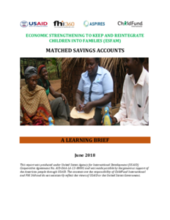Introduction
In Uganda and elsewhere, poverty is one of the key drivers of child-family separation and is linked to other, more specific constraints on the ability of families to provide for their children’s basic needs, including food, shelter, hygiene and access to health care and education. Caregivers’ inability to pay for costs associated with children’s education, in particular, is a challenge for the poorest families in Uganda. Lacking the means to pay for education, caregivers sometimes place their children in residential care institutions in the hope that they will be able to access free education.
A well-intentioned but inappropriate response to orphaning due to the AIDS epidemic, residential care institutions proliferated over the past 20 years. Needing to maintain a group of younger children in order to attract funding, some institutions began recruiting children. A body of evidence from multiple countries, however, indicates that institutionalization of children is widely linked to adverse cognitive, physical and social child development outcomes, as well as potential abuse and psychological distress. Institutional placement is generally a poor substitute for family care.
ChildFund International implemented the Economic Strengthening for Families (ESFAM) Project in Uganda’s Kamuli, Luwero and Gulu Districts. ESFAM was funded by USAID’s Displaced Children and Orphans Fund (DCOF) through FHI 360’s Accelerating Strategies for Practical Innovation and Research in Economic Strengthening (ASPIRES) project from November 2015 to June 2018. Its aim was to pilot and assess different economic strengthening interventions in programming aimed at preventing child-family separation and reintegrating separated children with their families. The project’s theory of change hypothesized that equipping families with the means to improve their economic situations would also improve their abilities to keep children in the household. The 700 families targeted by the project (611 identified to be at very high risk of separation and 89 with children who had been placed in residential care institutions and then subsequently reunified with their families) were invited to participate in one of three intervention packages, based on an assessment of the level of their economic vulnerability and anchored on particular economic interventions:
- Limited-term cash transfers plus optional participation in a saving group,
- A bank savings account in which ESFAM matched households’ deposits (matched savings account, or MSA) or
- Participation in a village-based saving and lending association (VSLA).
Each of these packages also included case management support to the child and family, development of family plans, and home visits including counseling and coaching on social and economic issues by para-social workers, training on child protection and parenting skills, and psychosocial support. Families reintegrating children also received a reunification package including food, bedding, clothing and funds for school uniforms.
This Learning Brief draws on information collected via focus group discussions, individual interviews, and project data to describe ESFAM’s experience with and learning from its MSA intervention, which aimed to encourage families to save for educational expenses, so that they would not have to send their children to residential care institutions for school.

